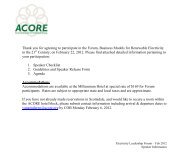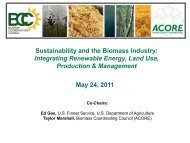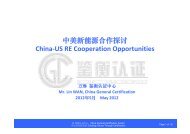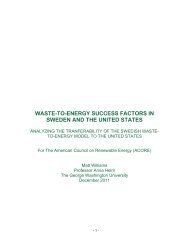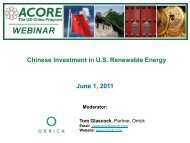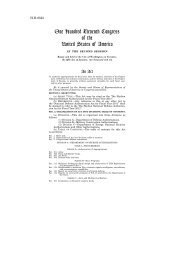Solar: Markets, Technologies, and PolicyOverviewSolar energy was one of the most-discussedtopics at RETECH 2009, ranging fromtechnology to policy, scale, and more.Decreasing costs, raising efficiency andmaximizing its presence in concentrated,distributed and building-integrated form are thegoals of the solar sector.ConsensusThe consensus at RETECH 2009 was that solarenergy is an extremely diverse renewable energysource whose benefits are still being discovered.From traditional crystalline applications, solarenergy is expanding outward to concentratedinstallations as well as adapting itself tobuildings and windows through thin-filmphotovoltaics. Grid parity is the endgame forsolar energy, with the combination of technologicalinnovation and supportive policypoised to deliver it. The <strong>American</strong> Recovery andReinvestment Act provides some neededcatalyzing factors for projects in the currentperiod of tight debt and credit markets.Solar TechnologySolar energy has a demonstrable valueproposition.Over its 50 years of use, solar energy hasdemonstrated merits on several levels.Delivering megawatts interchangeable with lessclimate-friendly energy generation options, solarpower’s fuel is free, and without constraints onboth supply and price. Solar installations have a25 to 50-year life, and close to a one-yearenergy payback period under its improving costcurve, said Paul Wormser, Senior Director,Engineering and Product Development of SharpSolar. Generating no pollution and no noise,solar power is available anywhere in the UnitedStates and globally. Solar power generation isviable on residential and commercial buildings,in centralized power plants, all the way down tocalculators, making it one of the most versatileand scalable forms of renewable energy.Solar cells are the basic building blocks of solarmodules, or solar collectors.The solar cell makes up any PV system, with silicon astheir fundamental element. Placed into ingots andarranged onto wafers, solar cells are the building blocks ofsolar modules. Cells are arranged into modules, combinedwith electronic components and installed on a structure.Solar energy has a relatively long history and abright future.Utilization of solar energy began in 1963 with crystallinepanels, off-grid panels that were usually found on residentialand commercial buildings. For today and in the future,crystalline panels can provide durability, efficiency(nearing 20% efficiency) and a proven performance record.A relatively new technology, thin film solar is a low-profile,low-cost, photovoltaic technology that has been “the nextbig thing in solar energy” for some time as it struggles tobolster its stability and enhance its durability.<strong>American</strong> <strong>Council</strong> <strong>On</strong> <strong>Renewable</strong> <strong>Energy</strong>Executive Summary Report 52
The technology debate: thin film versus panelsThere was discussion at RETECH about which technology—solar panels or thin film—would be the PV application ofthe future, with some consensus that a mixture of traditionalpanels and thin-film will bring the most benefit.The two technologies can coexist, said Wormser, forecastingthat a price increase spurred by heightened demandfor silicon will cause the market to go the thin film route,which requires less silicon. “From an efficiency standpoint,thin film can beat the cost per kWh of multi-crystalline PVpanel in some applications, delivering superior energy perunit of power capacity but less energy per unit of surfacearea.” Thin-film has a lower manufacturing cost, pointedout Wormser, but only at a higher volume, and it requiresmore man-hours to produce an equivalent output fromtraditional PV as a result of being generally less efficient.Clear, low-profile and increasingly durable, thin-film can beinstalled on windows, clear rooftops, and other newsurfaces where panels cannot be installed. From a prerecessionforecast of 70% growth per year for thin-filmtechnologies, Christopher O’Brien of Oerlikon Solarpredicts a still-substantial 50% rate of growth over thenext five years.Finance and EconomicsSolar photovoltaic growth continues its upswing.Accordingly, demand for photovoltaics hasskyrocketed since 2000, rising from lessthan 200 MW in 2000 to 4,500 in 2008, withGermany and Spain’s feed-in tariffs catalyzingtoday’s two largest markets. A consistent rise inGermany’s electricity prices, paired with adecreasing incentive curve have Germany’scost/KWh of solar and traditional electricitymeeting at some point between 2012 and 2017,according to Travis Bradford, President of thePrometheus Institute.Spain’s first feed-in tariff debuted in 2007 with a goal of400 MW to be installed by 2010. The program was hugelypopular, with 344 MW installed by September of 2007causing the government to temporarily suspend andrestructure the program, which went back into effectearlier this year. Spain is currently the world leader ininstalled solar capacity.Demand for solar modules is expected to stabilize in theneighborhood of 4,500-5,000 MW in 2009, resumegrowth as markets recover in 2010 and continue to growby an average of 32%, says Christopher O’Brien ofOerlikon Solar, taking the average of a number of studieson the topic. A 32% rate of annual growth would meanover 18,000 MW of modules in 2013, over four times thecurrent output.Solar energy’s cost curve is headed the rightdirection.The upward curve of module production is mirrored by adecreasing cost per MWh of electricity in solar energy’squest for grid parity. The weighted average price for ablended PV module in 2008 hovered between $3.00 and$3.50/watt, down from over $3.50 in 2006, and expectedto drop below $2.50 this year as thin film gains marketshare. The average price per mWh of electricity in theUnited States is currently 8.6 cents and rising as a resultof rising grid costs and increased demand. Electricitygenerated from solar panels currently stands at around$0.20/kWh, but Christopher O’Brien expects innovationand economies of scale to bring the cost to grid paritysometime after 2013 at about $0.13/kWh, resulting in ahuge solar boom.A dramatic increase in electricity prices makesolar’s price per kilowatt-hour more attractive.The national average price of electricity inthe United States rose by a stunning 10.9%during the period of April 2005 to April 2006.– Paul Wormser, Senior Director, Engineering and ProductDevelopment, Sharp SolarSolar energy’s attractive value proposition hinges onsolar’s ability to compete against traditional energysources. Electricity costs rose an average of 10.9% fromApril 2005- April 2006, with many major US energymarkets approaching or exceeding $0.20/kWh. Theaverage national price/kWh of 8.2 cents/kWh masksthese extreme cost outliers.Materials have become a high percentage ofsolar module costs.If its versatility is solar’s greatest merit, the high percentageof the materials used in solar equipment is its biggesthurdle to overcome. Material costs account for more thanhalf the total cost of module production, according toSolar Module Assembly Science and Technology Manager<strong>American</strong> <strong>Council</strong> <strong>On</strong> <strong>Renewable</strong> <strong>Energy</strong>Executive Summary Report 53
- Page 6:
The highlights of WIREC 2008 includ
- Page 9 and 10:
EVENT SPONSORSHosted byBadge Sponso
- Page 11 and 12:
EXHIBITORS ContinuedKamatics Corp.K
- Page 13 and 14: The ARRA contains the following ite
- Page 15 and 16: “How do we organize ourselves to
- Page 17 and 18: John GeesmanFormer Commissioner, Ca
- Page 19 and 20: Cathy ZoiCEO, Alliance for Climate
- Page 21 and 22: John CavalierManaging Partner, Huds
- Page 23 and 24: BiofuelsChristopher Groobey, Partne
- Page 25 and 26: Patrick Cloney, Executive Director,
- Page 27 and 28: Gal Luft, Executive Director, Insti
- Page 29 and 30: Daniel Kammen, Class of 1935 Distin
- Page 31 and 32: Biomass, Biofuels, and Advanced Veh
- Page 33 and 34: Critical development opportunities
- Page 35 and 36: ConclusionsSpeakers at RETECH 2009
- Page 37 and 38: Geothermal PowerOverviewThe United
- Page 39 and 40: Green Buildings and CommunitiesOver
- Page 41 and 42: Green construction and renovation s
- Page 43 and 44: Session ReferencesGreen Schools Bre
- Page 45 and 46: 1. The local electric power market
- Page 47 and 48: International Renewable Energy Indu
- Page 49 and 50: production was 37%; the domestic tu
- Page 51 and 52: There have been a number of incenti
- Page 53 and 54: educes mortality and improves gende
- Page 55 and 56: D7 - ChinaJing Su, Director of US-C
- Page 57 and 58: past, uncertain legislative environ
- Page 59 and 60: marketplace, accelerating and deepe
- Page 61 and 62: • Complexity and operating costs
- Page 63: C6 - Environmental and Carbon Finan
- Page 67 and 68: FITs have grown in popularity over
- Page 69 and 70: Haroula Reitz, Global Manager of Sc
- Page 71 and 72: Currently, planning is geographical
- Page 73 and 74: Federal policy should allow for a c
- Page 75 and 76: Wind: Markets, Technologies, and Po
- Page 77 and 78: Regional FactorsBesides federal pol






